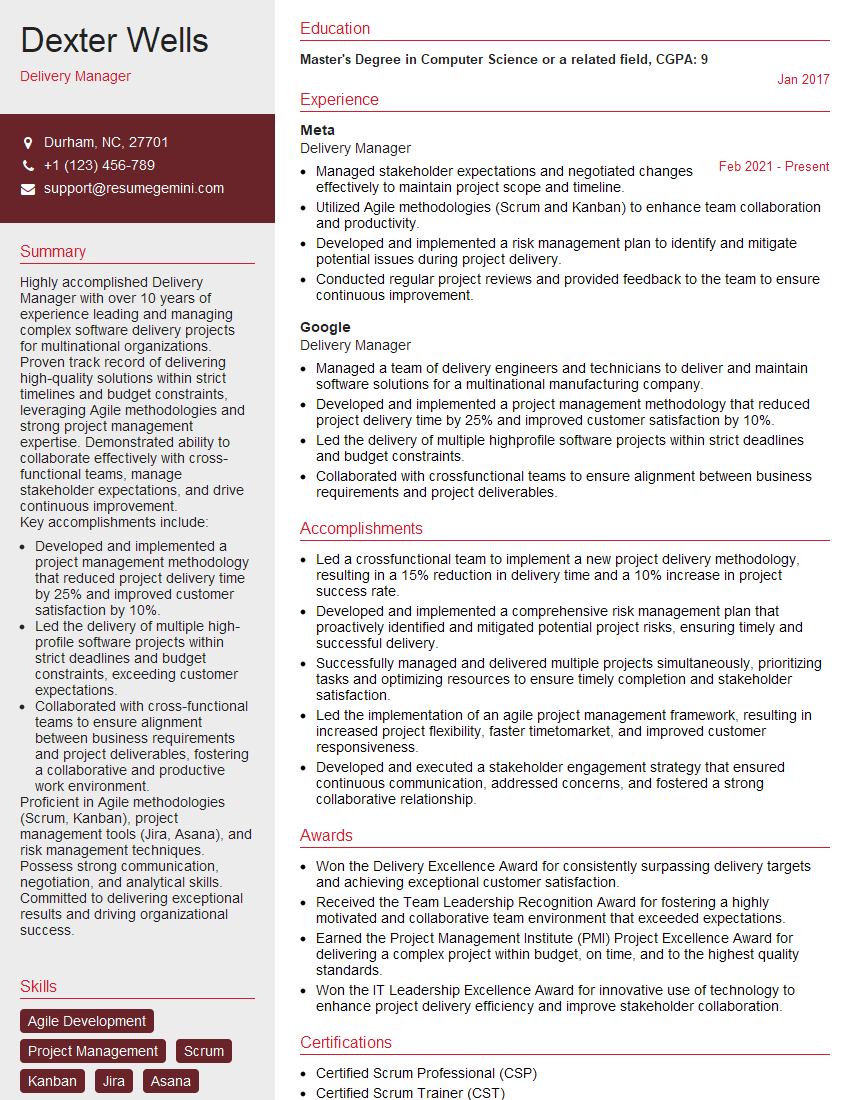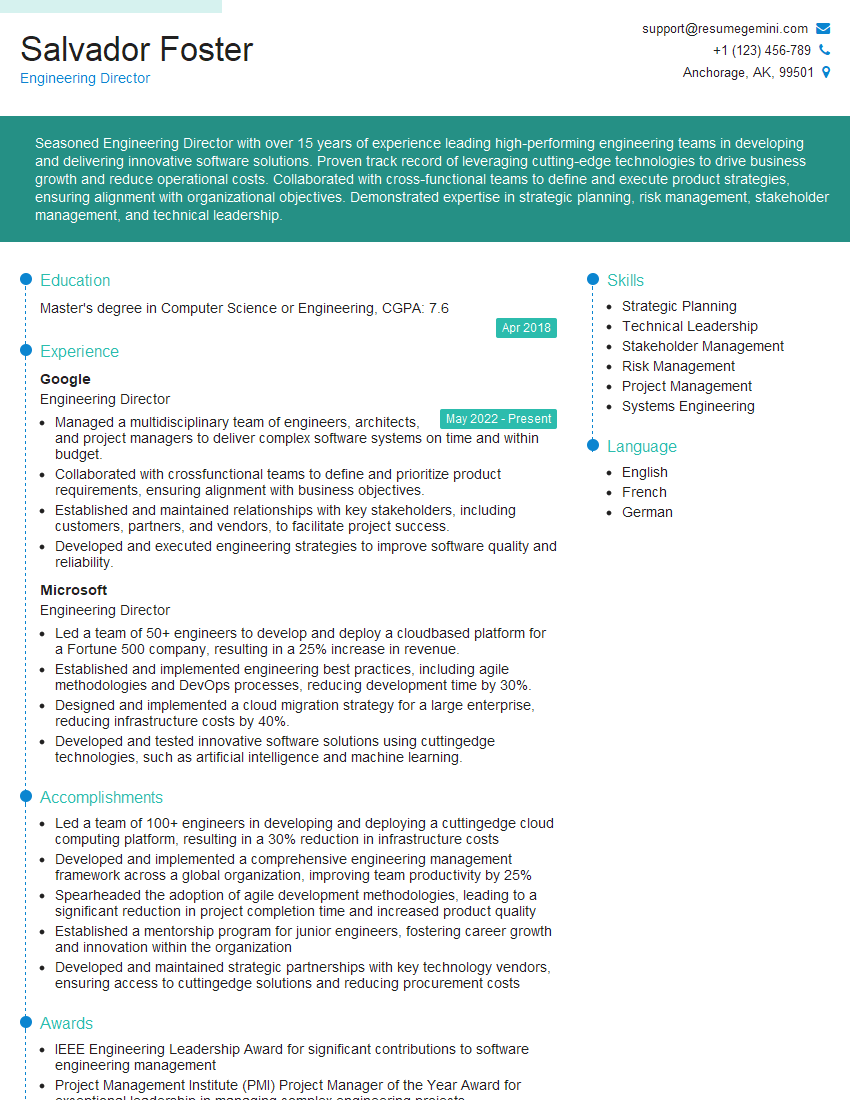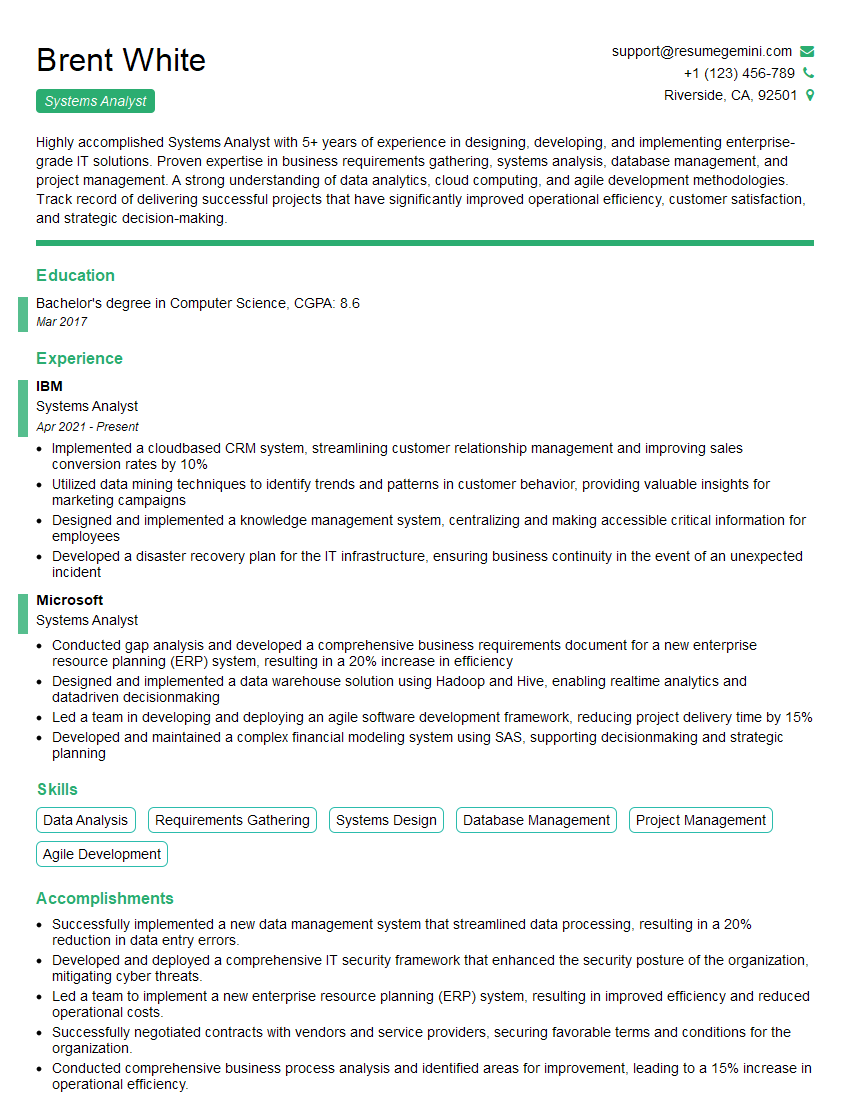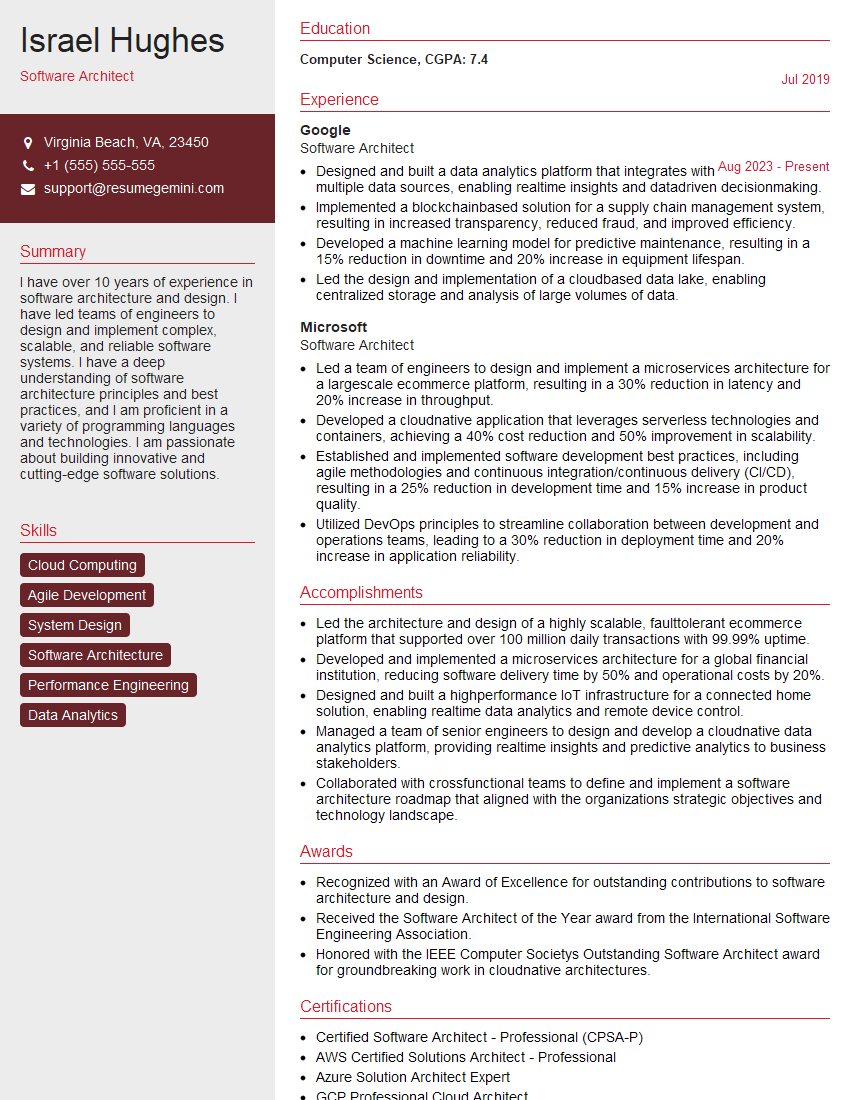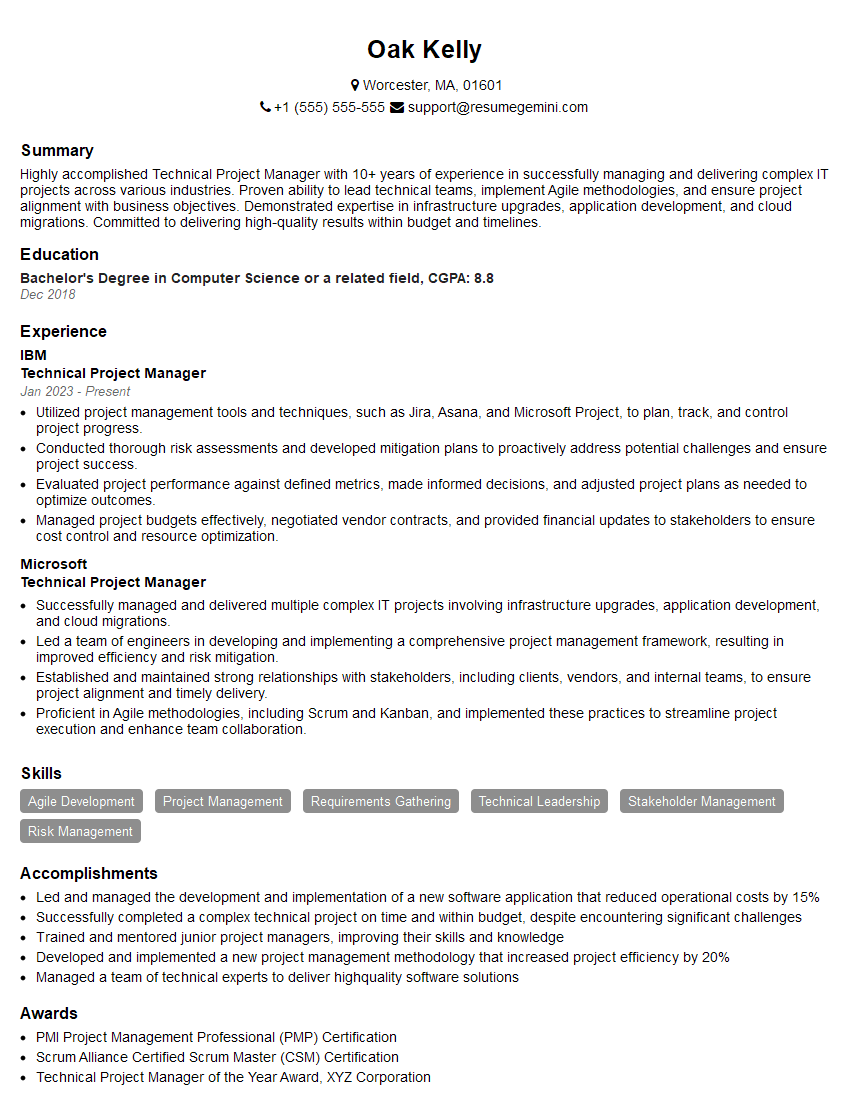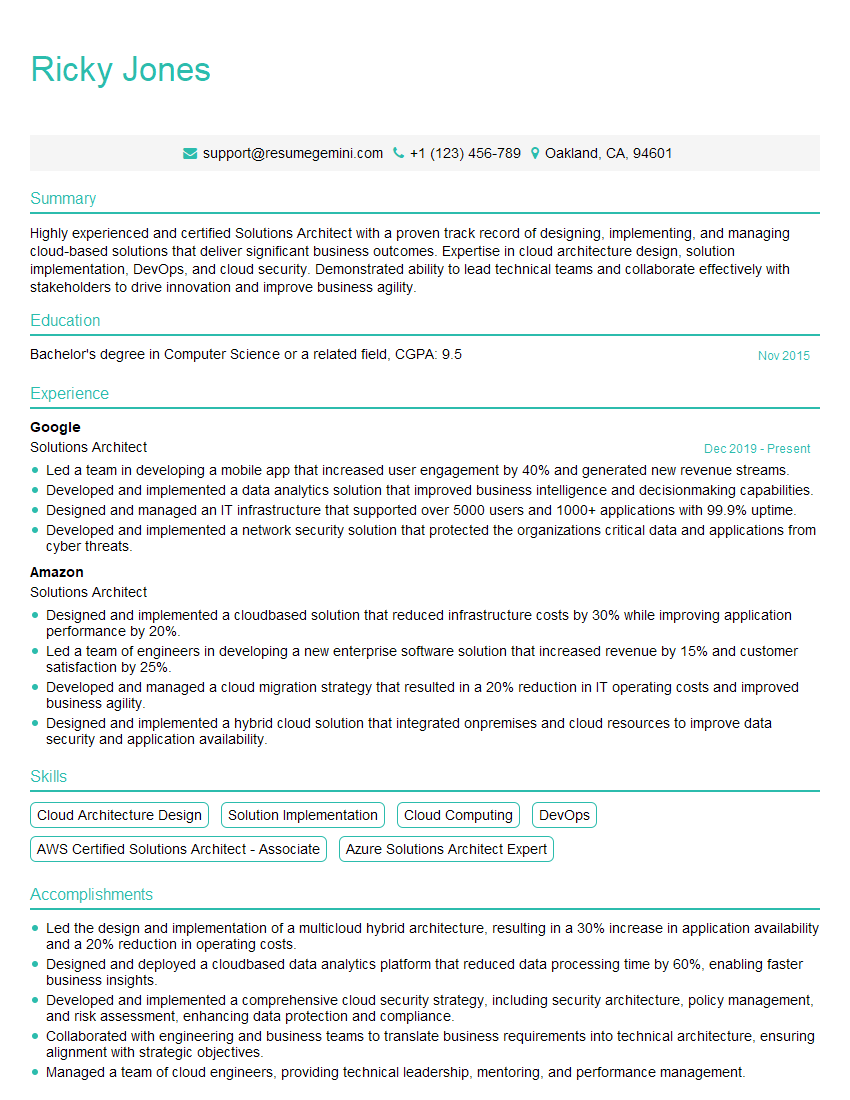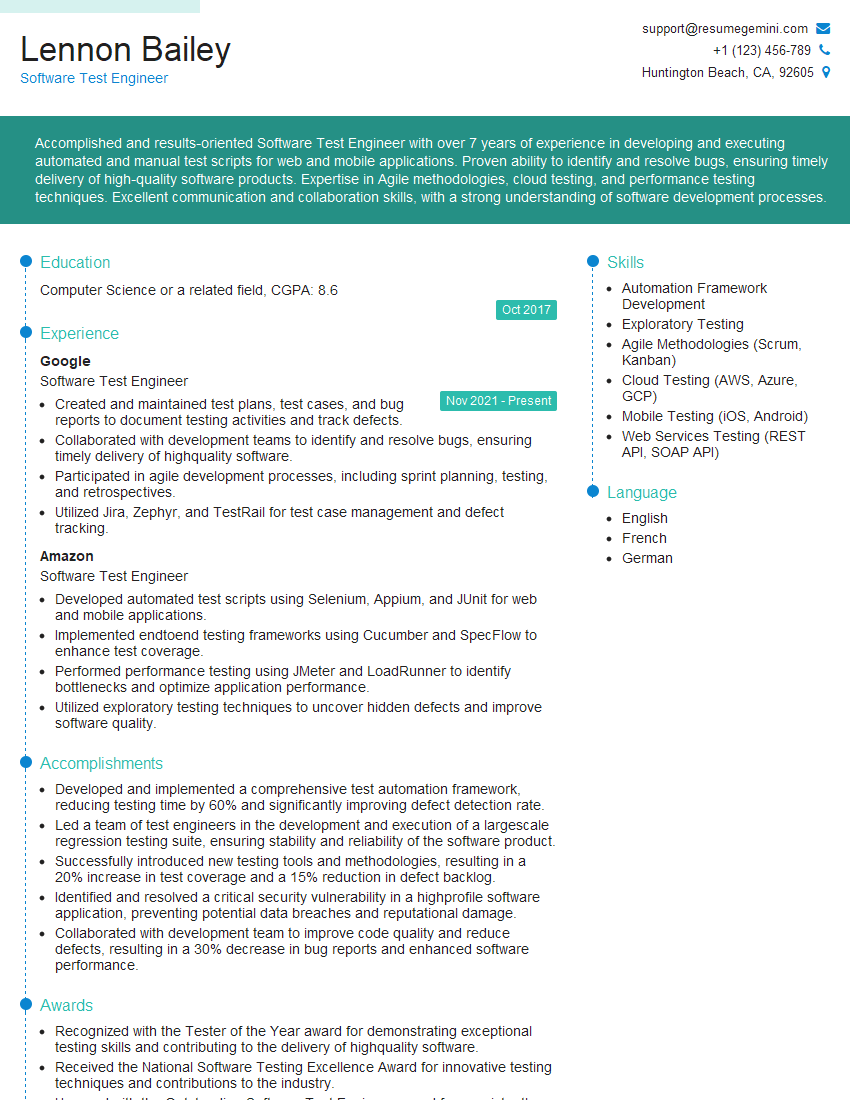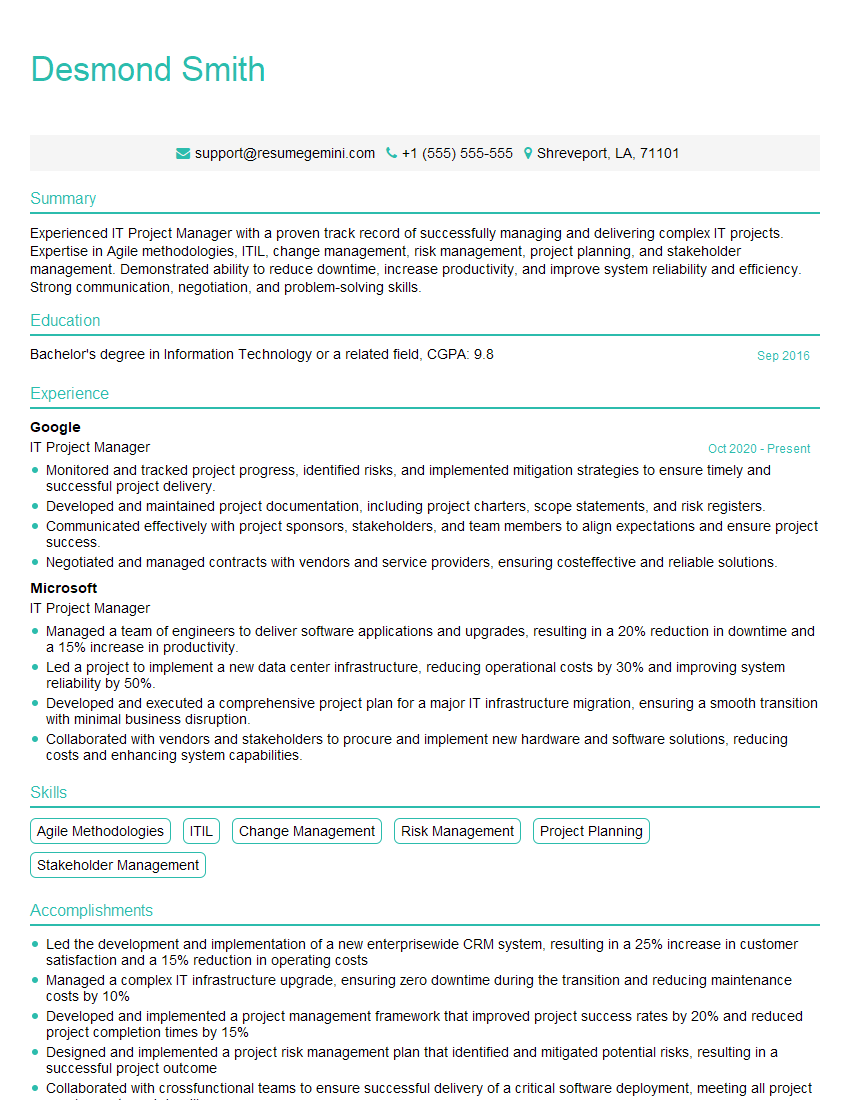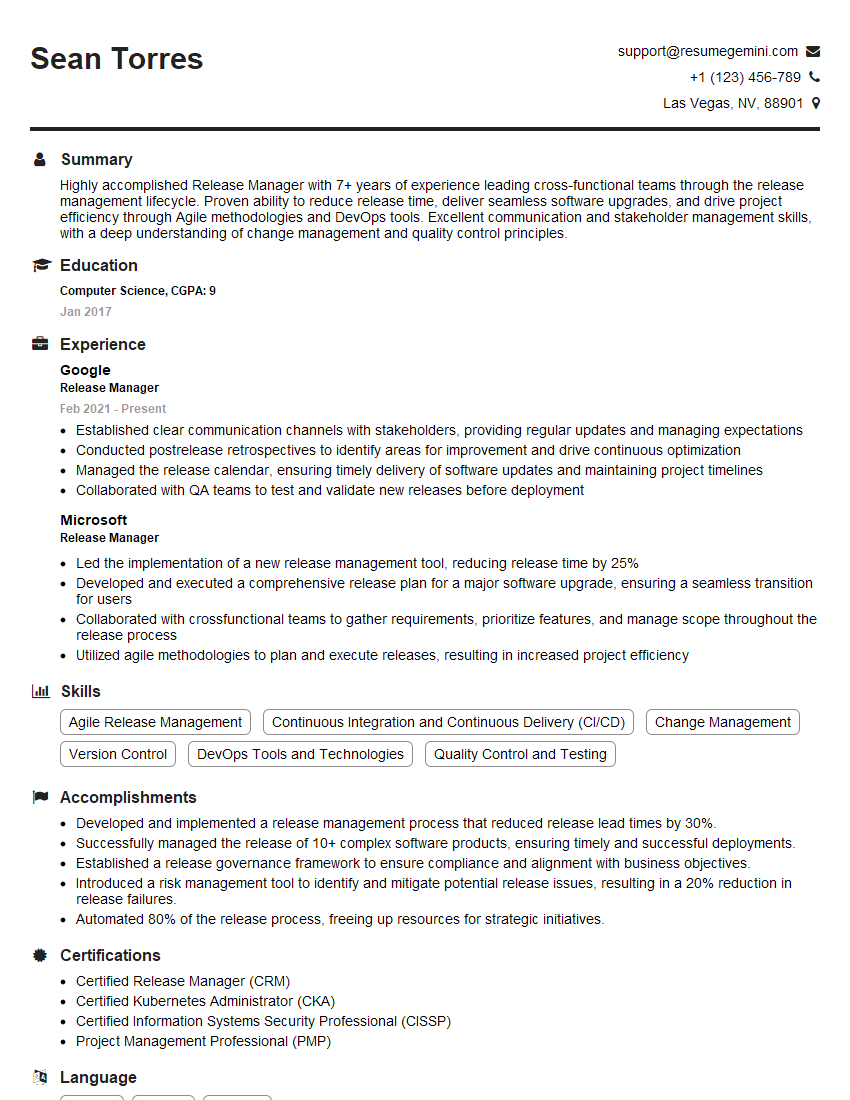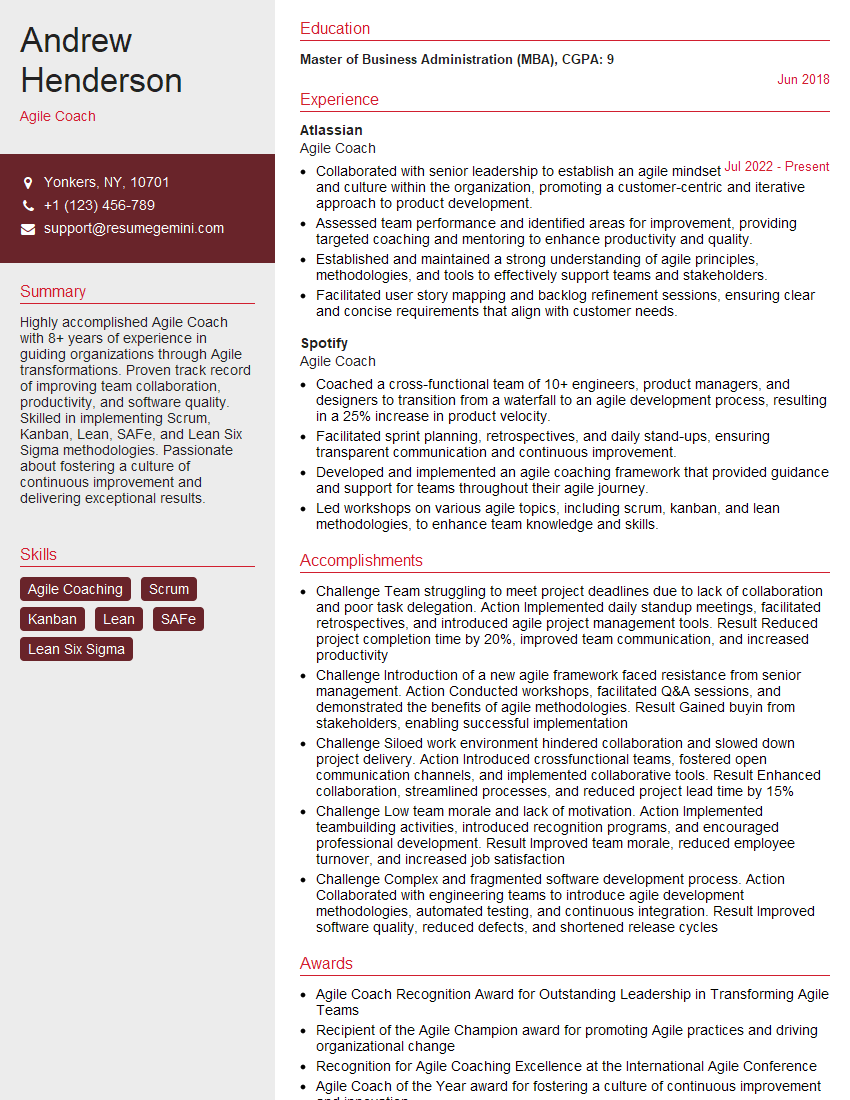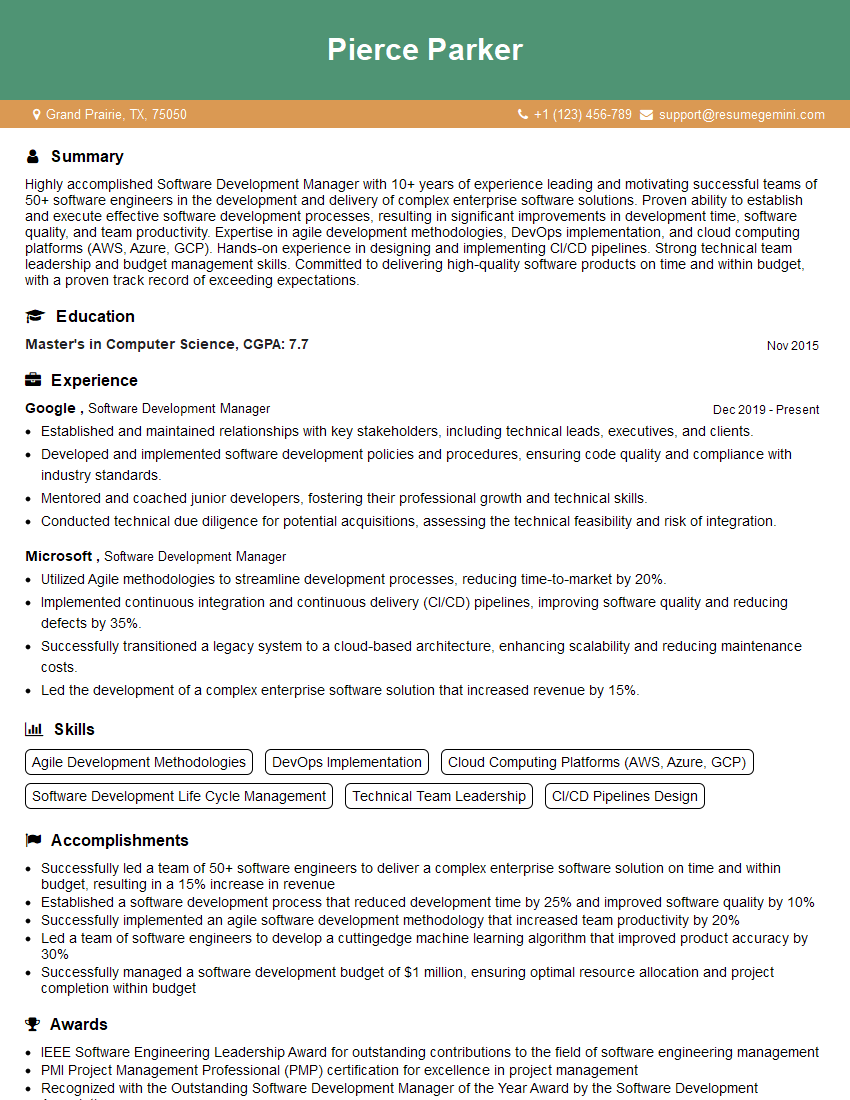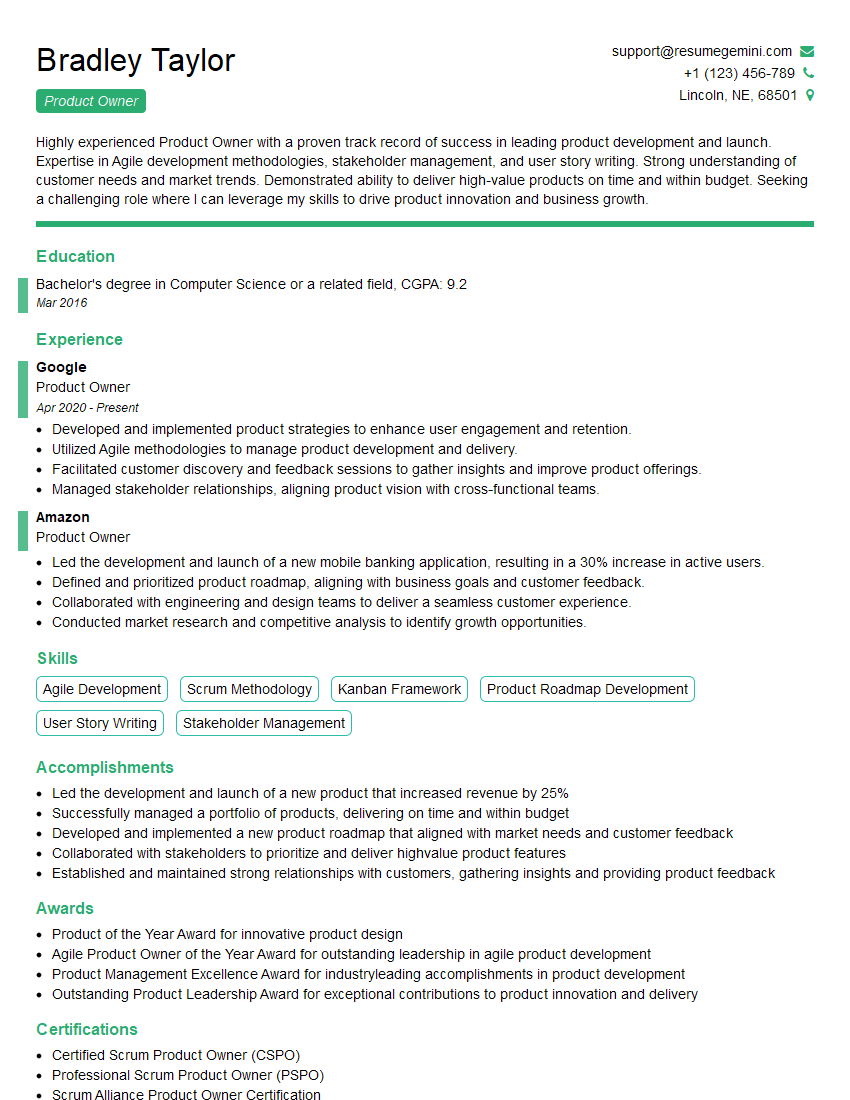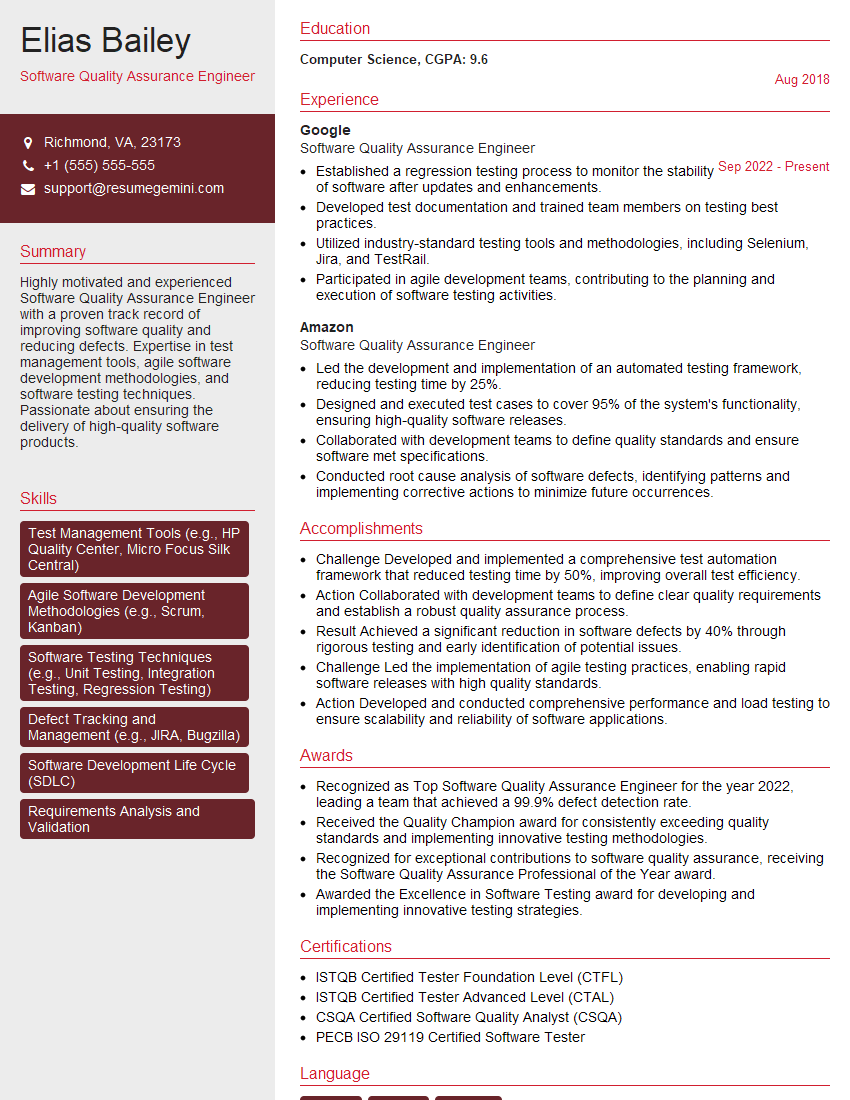Feeling uncertain about what to expect in your upcoming interview? We’ve got you covered! This blog highlights the most important Software Development Process interview questions and provides actionable advice to help you stand out as the ideal candidate. Let’s pave the way for your success.
Questions Asked in Software Development Process Interview
Q 1. Explain the Software Development Life Cycle (SDLC).
The Software Development Life Cycle (SDLC) is a structured process for planning, creating, testing, and deploying software. Think of it as a roadmap for building a software product, ensuring a smooth and efficient journey from concept to launch. It involves several key phases, which can vary slightly depending on the chosen methodology (like Waterfall or Agile), but generally include requirements gathering, design, implementation (coding), testing, deployment, and maintenance. Each phase has specific goals and deliverables, promoting a systematic approach to software development.
For example, the requirements gathering phase involves understanding the client’s needs and translating them into specific software requirements. The design phase focuses on creating the architecture and user interface. Implementation involves writing the code, and testing ensures the software functions as expected. Deployment is the release of the software to users, and maintenance involves ongoing updates and bug fixes.
Q 2. Describe the Waterfall methodology. What are its advantages and disadvantages?
Waterfall is a linear, sequential SDLC methodology. Imagine building a house – you wouldn’t start painting before the foundation is laid. Similarly, in Waterfall, each phase must be completed before the next one begins. Requirements are thoroughly documented upfront, and changes are difficult and costly to implement later in the process.
- Advantages: Simple to understand and manage; well-defined stages; clear documentation; easy to track progress.
- Disadvantages: Inflexible; difficult to accommodate changing requirements; limited client involvement; testing is done late in the cycle, leading to potentially costly rework.
For instance, if during the testing phase of a Waterfall project, a crucial requirement is discovered to be missing, it would require significant rework and potentially delay the entire project.
Q 3. Describe the Agile methodology. What are its advantages and disadvantages?
Agile is an iterative and incremental SDLC methodology. Instead of a rigid, linear approach, Agile emphasizes flexibility and collaboration. It involves breaking down the project into smaller, manageable chunks called sprints, allowing for frequent feedback and adjustments throughout the development process. Think of it as building with LEGOs – you can constantly adapt and improve your design as you go.
- Advantages: Flexible and adaptable to changing requirements; promotes collaboration and client involvement; frequent feedback loops; faster time to market; improved quality through continuous testing.
- Disadvantages: Requires experienced and self-managing teams; can be challenging to manage in large projects; documentation might be less comprehensive than Waterfall; potential for scope creep if not managed properly.
Imagine developing a mobile app using Agile. You’d start with a Minimum Viable Product (MVP) – a basic version with core features – and then iteratively add more features based on user feedback in subsequent sprints.
Q 4. Compare and contrast Waterfall and Agile methodologies.
Waterfall and Agile are fundamentally different in their approaches to software development. Waterfall is sequential and rigid, while Agile is iterative and flexible. Waterfall prioritizes comprehensive upfront planning, while Agile embraces change and adaptation. Waterfall relies on extensive documentation, while Agile focuses on working software and frequent communication. Waterfall suits projects with stable requirements, while Agile thrives in environments with evolving needs.
Imagine building a bridge (Waterfall) versus designing a website (Agile). Building a bridge requires meticulous planning and adherence to a strict plan. Designing a website allows for flexibility and changes based on user feedback and evolving trends.
Q 5. What is Scrum? Explain its key roles and ceremonies.
Scrum is a specific Agile framework that provides a structured approach to iterative software development. It utilizes short cycles called sprints (typically 2-4 weeks) to deliver incremental value. Key roles include:
- Product Owner: Defines the product backlog (list of features) and prioritizes them.
- Scrum Master: Facilitates the Scrum process and removes impediments.
- Development Team: A self-organizing team responsible for building the software.
Key Scrum ceremonies include:
- Sprint Planning: The team plans the work for the upcoming sprint.
- Daily Scrum: A short daily meeting to track progress and identify roadblocks.
- Sprint Review: A demonstration of the completed work at the end of the sprint.
- Sprint Retrospective: A meeting to reflect on the sprint and identify areas for improvement.
For example, a development team using Scrum might dedicate a sprint to building the core login functionality of an e-commerce website, then another sprint for the product catalog, and so on.
Q 6. What is Kanban? How does it differ from Scrum?
Kanban is a visual workflow management system that focuses on visualizing and limiting work in progress (WIP). It uses a Kanban board to track tasks as they move through different stages of development. Unlike Scrum, Kanban doesn’t prescribe specific roles or ceremonies, offering greater flexibility.
The key difference between Kanban and Scrum lies in their approach to iteration. Scrum uses fixed-length sprints, while Kanban emphasizes continuous flow. Scrum has defined roles and ceremonies, whereas Kanban is more flexible and adaptable. Scrum is more structured, while Kanban is more lightweight.
Imagine a car assembly line (Kanban) versus a team working on sprints (Scrum). The car assembly line continuously produces cars, while Scrum teams complete work in a defined timeframe.
Q 7. What are sprints and how are they used in Agile development?
In Agile development, sprints are short, time-boxed iterations (usually 2-4 weeks) during which a specific amount of work is planned and completed. Each sprint results in a potentially shippable increment of the software. Think of sprints as mini-projects within the larger project. They promote iterative development, allowing for frequent feedback and adjustments, and minimizing risk.
For example, a sprint might focus on implementing a new feature, fixing bugs, or improving the user interface. At the end of each sprint, the team demonstrates the working software to stakeholders and gathers feedback, which is then incorporated into the planning of the next sprint.
Q 8. Explain the concept of continuous integration and continuous delivery (CI/CD).
Continuous Integration and Continuous Delivery (CI/CD) is a set of practices that automates the process of building, testing, and deploying software. Think of it like an assembly line for software, but instead of cars, we’re building and releasing software updates.
Continuous Integration (CI) focuses on frequently integrating code changes into a shared repository. Each integration is then verified by an automated build and automated tests. This early and frequent integration helps detect integration issues quickly, preventing them from becoming larger problems later on. Imagine a team of builders working on different parts of a house. CI ensures they check their work frequently to make sure all the parts fit together smoothly.
Continuous Delivery (CD) extends CI by automating the release process. Once code passes all automated tests, it’s automatically deployed to a staging or production environment. This allows for faster and more frequent releases, enabling quicker feedback loops and faster response to changing user needs. It’s like having a conveyor belt that automatically transports the finished house sections to their final location.
Example: A team uses Git for version control, Jenkins for automated builds, and Docker for containerization. Every time a developer pushes code to the Git repository, Jenkins automatically builds the application, runs unit and integration tests, and then deploys the application to a staging environment for further testing before final deployment to production.
Q 9. What are some common metrics used to track software development progress?
Tracking software development progress requires a balanced approach, using both quantitative and qualitative metrics. Some common metrics include:
- Velocity: Measures the amount of work a team completes in a given sprint (e.g., story points). This helps predict future progress and identify potential bottlenecks.
- Defect Density: The number of defects found per lines of code or per module. A high defect density indicates potential quality issues.
- Cycle Time: The time it takes to complete a single task or user story from start to finish. A shorter cycle time indicates efficient processes.
- Lead Time: The time it takes for a change to move from idea to deployment. A reduced lead time reflects faster delivery capabilities.
- Code Coverage: The percentage of code that is covered by automated tests. High code coverage helps ensure better quality and reduces the risk of regressions.
- Customer Satisfaction (CSAT): Gauges user happiness with the released software through surveys or feedback forms. This helps measure the impact of the development efforts.
The choice of metrics depends on the project’s specific goals and context. It’s crucial to avoid solely focusing on a single metric, as this could lead to skewed priorities and potentially neglecting other important aspects.
Q 10. How do you handle scope creep in a project?
Scope creep, the uncontrolled expansion of project requirements, is a major threat to project success. Effective management involves a proactive and collaborative approach:
- Clearly Defined Scope: Start with a detailed and well-documented project scope statement that includes features, functionalities, and acceptance criteria. Use tools like user stories and a well-defined product backlog.
- Change Management Process: Establish a formal process for requesting and approving changes. This includes assessing the impact on the schedule, budget, and resources.
- Regular Monitoring: Track project progress closely and identify potential scope creep early. Use burndown charts and regular sprint reviews to monitor progress against the plan.
- Prioritization: Prioritize features based on business value and user needs. Use techniques like MoSCoW method (Must have, Should have, Could have, Won’t have) to prioritize requirements.
- Communication: Maintain open and transparent communication with stakeholders. Keep them informed about any changes and their potential impact.
Example: If a new feature request arises during a sprint, the team assesses its impact on the sprint goal and existing tasks. If it significantly alters the scope, it’s documented as a future enhancement and not included in the current sprint.
Q 11. Describe your experience with risk management in software development.
Risk management is crucial in software development. My approach involves a combination of proactive identification, assessment, and mitigation strategies:
- Risk Identification: I use brainstorming sessions, checklists, and SWOT analysis to identify potential risks, including technical challenges, resource constraints, schedule slips, and stakeholder conflicts.
- Risk Assessment: Each identified risk is assessed based on its likelihood and potential impact. This helps prioritize risks and allocate resources effectively.
- Risk Mitigation: Develop strategies to reduce the likelihood or impact of identified risks. These strategies can include contingency planning, risk transfer (insurance), risk avoidance (avoiding risky tasks), and risk reduction (improving processes).
- Risk Monitoring: Regularly monitor identified risks and their impact throughout the project lifecycle. This helps to track the effectiveness of the mitigation strategies and make adjustments as needed.
Example: In a project involving a new technology, I identified the risk of technical challenges. To mitigate this, I allocated extra time for research and development, included experienced personnel, and implemented thorough testing procedures.
Q 12. How do you prioritize tasks in a software development project?
Task prioritization is critical for efficient project management. My approach uses a combination of techniques:
- Value vs. Effort: Prioritize tasks based on their business value and the effort required to complete them. High-value, low-effort tasks should be tackled first.
- Dependency Analysis: Identify dependencies between tasks to ensure a logical order of execution. Tasks with dependencies on other tasks cannot be started until the dependencies are met.
- Risk-Based Prioritization: Prioritize tasks that pose higher risks to project success. Addressing high-risk tasks early can prevent major problems later on.
- MoSCoW Method: Categorize tasks as Must have, Should have, Could have, Won’t have to clarify priorities and manage expectations.
- Agile Methodologies: Employ agile techniques such as sprint planning and backlog refinement to iteratively prioritize tasks based on changing needs and priorities.
Example: In a project with a tight deadline, I would prioritize critical functionalities (Must have) before addressing less critical features (Should have).
Q 13. What is your experience with different testing methodologies (e.g., unit, integration, system, acceptance)?
I have extensive experience with various testing methodologies, each serving a different purpose in ensuring software quality:
- Unit Testing: Testing individual components or units of code in isolation. This is typically done by developers using frameworks like JUnit or pytest.
assert function_result(5) == 10 - Integration Testing: Testing the interaction between different components or modules. This ensures that the components work correctly together.
- System Testing: Testing the entire system as a whole to verify that it meets the specified requirements. This often involves end-to-end testing scenarios.
- Acceptance Testing: Testing the system from the end-user perspective to ensure that it meets their needs and expectations. This often involves user acceptance testing (UAT).
The choice of testing methodology depends on the project’s complexity and requirements. A comprehensive testing strategy typically incorporates all these levels to achieve thorough validation.
Q 14. How do you ensure quality in software development?
Ensuring quality in software development requires a multifaceted approach that encompasses various stages of the development lifecycle:
- Code Reviews: Peer reviews help identify potential bugs and improve code quality. This collaborative approach promotes knowledge sharing and consistency.
- Automated Testing: Implementing a robust automated testing framework ensures that code changes don’t introduce regressions. This allows for frequent testing with minimal effort.
- Static Code Analysis: Use static analysis tools to automatically identify potential bugs and vulnerabilities in the code without actually running it.
- Continuous Integration/Continuous Delivery (CI/CD): Implementing CI/CD allows for automated building, testing, and deployment of code, helping to identify problems early and often.
- Quality Metrics: Tracking metrics like defect density, code coverage, and customer satisfaction helps assess the quality of the software and identify areas for improvement.
A culture of quality needs to be fostered throughout the development team, with shared responsibility for ensuring quality from the design phase to deployment and maintenance.
Q 15. Explain your experience with version control systems (e.g., Git).
Version control systems, like Git, are fundamental to modern software development. They track changes to code over time, allowing for collaboration, rollback to previous versions, and efficient management of different features or bug fixes. My experience with Git spans several years and encompasses all its core functionalities.
I’m proficient in branching strategies (like Gitflow or GitHub Flow), creating and merging branches, resolving merge conflicts, using pull requests for code review, and managing remote repositories on platforms like GitHub and GitLab. For example, I’ve used Git’s branching capabilities extensively to manage parallel development of features in a large-scale project. One branch might have been dedicated to UI improvements while another handled backend API changes. This prevented conflicts and allowed for independent testing before integration.
I’m also comfortable with using Git commands directly from the command line, though I also utilize graphical interfaces like Sourcetree for visual representation of the project’s history and easier conflict resolution. I understand the importance of writing clear, concise commit messages to document changes and improve code maintainability.
Career Expert Tips:
- Ace those interviews! Prepare effectively by reviewing the Top 50 Most Common Interview Questions on ResumeGemini.
- Navigate your job search with confidence! Explore a wide range of Career Tips on ResumeGemini. Learn about common challenges and recommendations to overcome them.
- Craft the perfect resume! Master the Art of Resume Writing with ResumeGemini’s guide. Showcase your unique qualifications and achievements effectively.
- Don’t miss out on holiday savings! Build your dream resume with ResumeGemini’s ATS optimized templates.
Q 16. How do you handle conflicts in a team environment?
Conflicts are inevitable in a team environment. My approach emphasizes proactive communication and clear coding practices to minimize them, but when they arise, I follow a structured process.
- Understanding the Conflict: First, I carefully examine the conflicting changes. I try to understand the reasons behind each change and their impact on the overall project.
- Communication: I directly communicate with the other developer(s) involved to discuss the changes and find a solution together. A quick chat or a brief meeting often resolves the issue quickly.
- Resolution Strategies: Depending on the complexity, we might choose to merge manually by carefully reviewing both versions and selecting the best parts or use Git’s merge tools. If the changes are significant and complex, we might refactor the code to improve the merging process and avoid future conflicts.
- Testing: After resolving the conflict, thorough testing is crucial to ensure that the fix works as intended and doesn’t introduce new issues. We perform unit tests and integration tests to confirm this.
In my experience, proactive communication is paramount. Regular code reviews, coupled with well-defined branching strategies, drastically reduce the number and complexity of conflicts encountered.
Q 17. Describe a time you had to troubleshoot a critical issue in a software development project.
During a recent project involving a real-time chat application, we encountered a critical issue where the application would occasionally crash under high load. This was a production issue, impacting users directly. My role involved troubleshooting and resolving this.
Our initial investigation pointed towards database connection issues. However, after thorough monitoring and log analysis, it became clear that the problem stemmed from a memory leak within a particular module handling user message processing. We used debugging tools to identify the exact source of the memory leak—a loop that wasn’t properly releasing memory after processing large messages.
The solution involved optimizing the memory management in that module by implementing proper resource cleanup and using more efficient data structures. We deployed the fix using a phased rollout to minimize the risk of further disruptions. The problem was solved, and the application became stable. This experience emphasized the importance of rigorous testing, effective monitoring, and systematic debugging.
Q 18. What are some common challenges in software development and how do you overcome them?
Software development presents many challenges; some of the most common include:
- Scope Creep: Uncontrolled expansion of project requirements. This is addressed through meticulous requirements gathering, prioritization, and the use of agile methodologies, including iterative development and regular sprint reviews.
- Technical Debt: Choosing quick solutions that compromise long-term maintainability. This is handled through code reviews, refactoring, and prioritizing the reduction of technical debt alongside new feature development.
- Communication Breakdown: Poor communication among team members. This is mitigated by having clearly defined roles, regular team meetings, and using effective communication tools.
- Unrealistic Deadlines: Pressure to deliver before adequate testing and development. This is tackled through careful planning, realistic estimations, and open communication with stakeholders about potential risks and delays.
Overcoming these challenges involves adopting best practices, using appropriate tools, and fostering a culture of collaboration and communication within the development team.
Q 19. What is your preferred approach to requirements gathering?
My preferred approach to requirements gathering is a collaborative one, combining various techniques.
- Stakeholder Interviews: I conduct in-depth interviews with key stakeholders to understand their needs and expectations. This involves open-ended questions to uncover underlying needs, not just stated requirements.
- User Stories: I use user stories (e.g., “As a user, I want to be able to… so that…”) to capture functional requirements in a clear and concise manner.
- Use Cases: For more complex functionalities, I create use cases to illustrate the flow of interactions between the user and the system.
- Prototyping: Early prototypes are vital for validating requirements and gathering feedback. This allows for early detection and correction of misunderstandings.
This multi-faceted approach ensures that the requirements are well-understood, documented, and aligned with the stakeholders’ vision. It also helps to avoid misunderstandings and reduces the likelihood of scope creep.
Q 20. How do you ensure effective communication within a development team?
Effective communication is critical for a successful software development project. I use a combination of techniques to ensure seamless communication within the team.
- Daily Stand-up Meetings: Short daily meetings to discuss progress, roadblocks, and coordinate work.
- Regular Team Meetings: More in-depth meetings to discuss project status, address issues, and plan future sprints.
- Collaboration Tools: Utilizing tools like Slack, Microsoft Teams, or similar platforms for quick communication, file sharing, and task management.
- Code Reviews: Formal code reviews are a valuable tool for communication, knowledge sharing, and ensuring code quality.
- Documentation: Clear and comprehensive documentation of code, processes, and decisions helps maintain consistency and transparency.
Clear, frequent, and open communication prevents misunderstandings and ensures everyone is on the same page. Transparency is key to building trust and fostering a collaborative environment.
Q 21. What tools and technologies are you familiar with for managing software development processes?
I’m familiar with a wide range of tools and technologies for managing software development processes. My experience includes:
- Version Control Systems: Git (GitHub, GitLab, Bitbucket)
- Project Management Tools: Jira, Asana, Trello
- Collaboration Platforms: Slack, Microsoft Teams
- CI/CD Tools: Jenkins, GitLab CI, CircleCI
- Code Review Tools: GitHub, GitLab, Crucible
- Bug Tracking Systems: Jira, Bugzilla
- Documentation Tools: Confluence, Swagger
My choice of tools depends on the specific project’s needs and team preferences. However, the underlying principle is always to leverage technology to streamline workflows, enhance collaboration, and improve overall efficiency.
Q 22. Explain your experience with project management methodologies (e.g., PRINCE2, PMI).
My experience encompasses several project management methodologies, most notably Agile (Scrum and Kanban) and, to a lesser extent, PRINCE2. Agile methodologies, with their iterative and incremental approach, have been central to my work, allowing for flexibility and responsiveness to evolving client needs. I’ve successfully led and participated in Scrum teams, utilizing sprint planning, daily stand-ups, sprint reviews, and retrospectives to deliver high-quality software within defined timeframes. My experience with PRINCE2, while less extensive, has provided a valuable framework for understanding structured project planning and risk management, particularly in larger, more complex projects requiring meticulous documentation and control. I’ve found that a hybrid approach, blending the flexibility of Agile with the structure of PRINCE2 where appropriate, is often the most effective.
For example, in a recent project involving the development of a large-scale e-commerce platform, we adopted a Scrum framework. This allowed us to rapidly develop and test features in short iterations, incorporating client feedback at each stage. We used PRINCE2 principles to define the overall project scope, manage risks and resources effectively, and ensure compliance with regulatory requirements. This blend ensured efficient execution while mitigating risks.
Q 23. How do you handle changing priorities in a project?
Handling changing priorities requires a proactive and collaborative approach. The first step is to understand the rationale behind the change. Why is the priority shifting? What are the business implications? Once understood, I use a combination of techniques to adapt. This includes:
- Reprioritization: Using a prioritization framework (like MoSCoW – Must have, Should have, Could have, Won’t have), we re-evaluate the project backlog, assessing the impact of the change on the overall project goals and timeline.
- Communication: Transparent communication is crucial. I inform the team immediately about the change, explaining the rationale and its impact on their tasks. This ensures everyone is on board and understands the new direction.
- Scope Management: If the changes significantly impact the project scope, we formally adjust the project scope document, defining new deliverables and timelines. This might involve adjusting the budget or resource allocation.
- Risk Assessment: We re-evaluate potential risks associated with the change and develop mitigation strategies. This ensures we stay ahead of potential problems.
For instance, if a critical security vulnerability is discovered mid-project, the priority shifts immediately to address it, even if it means temporarily delaying other tasks. The change is communicated, the impacted tasks are re-prioritized, and additional resources may be allocated as needed.
Q 24. What is your understanding of technical debt and how to manage it?
Technical debt refers to the implied cost of rework caused by choosing an easy (limited) solution now instead of using a better approach that would take longer. It’s like taking a shortcut that might seem convenient now but creates problems later. Managing technical debt involves a balance. Ignoring it leads to escalating costs and maintenance nightmares; addressing *all* of it immediately can stifle progress.
My approach to managing technical debt includes:
- Identification: Regularly identifying areas of technical debt through code reviews, automated testing, and monitoring system performance.
- Prioritization: Categorizing technical debt based on severity and impact. High-impact, high-risk debt is addressed first. Tools like issue tracking systems are invaluable here. We might use a scoring system considering risk and cost of refactoring.
- Planning: Allocating dedicated time within sprints or iterations for refactoring and improving code quality. This is crucial; it’s not something that should be left to the last minute.
- Documentation: Carefully documenting technical debt, explaining the reasons for the shortcuts, and the planned mitigation strategies. This ensures continuity and helps future developers avoid falling into the same traps.
For example, if we use a quick-and-dirty solution for a specific feature to meet a tight deadline, we document it as technical debt, noting its potential impact on performance and maintainability. We then schedule time in a subsequent sprint to refactor the code to a more robust and sustainable solution.
Q 25. Describe your experience with different types of software development documentation.
My experience encompasses a wide range of software development documentation, including:
- Requirements Documents: These outline the functional and non-functional requirements of the software, serving as the basis for design and development. I’ve worked with both formal documents (e.g., using UML diagrams) and less formal, Agile-style user stories.
- Design Documents: These describe the architecture, design patterns, and algorithms used in the software. They might include class diagrams, sequence diagrams, and database schemas.
- Technical Specifications: These provide detailed technical information about the software’s components and interfaces, guiding the development team.
- User Manuals & Guides: These explain how to use the software, catering to different user levels.
- API Documentation: Detailed descriptions of APIs (Application Programming Interfaces) allowing other systems to integrate with the software. Often this uses tools like Swagger or OpenAPI Spec.
- Test Plans and Test Cases: Thorough plans and specific test cases to ensure the quality and functionality of the software.
- Code Comments and Documentation: Well-commented and documented code is essential for maintainability and future development.
The type and level of detail in documentation depend on the project’s size, complexity, and the chosen development methodology. For smaller Agile projects, documentation might be more lightweight and focused on user stories and code comments, while larger projects might require more extensive, formal documents.
Q 26. What is your approach to debugging and problem-solving in software development?
My approach to debugging and problem-solving is systematic and iterative. I don’t jump to conclusions; instead, I follow a structured process:
- Reproduce the Bug: The first step is to consistently reproduce the bug. This provides a controlled environment for investigation.
- Gather Information: Collect relevant information, such as error messages, logs, and stack traces. Analyzing these provides critical clues.
- Isolate the Problem: Try to pinpoint the specific code section or component causing the issue using techniques like binary search or selective disabling of code blocks.
- Formulate Hypotheses: Based on the gathered information, develop hypotheses about the root cause of the bug.
- Test Hypotheses: Systematically test the hypotheses using debugging tools, print statements, or logging.
- Implement Solution: Once the root cause is identified, implement the necessary fix.
- Test Fix: Thoroughly test the implemented solution to ensure it addresses the bug and doesn’t introduce new ones.
- Learn from the Experience: After resolving the bug, reflect on the process and identify ways to prevent similar issues in the future.
For example, if I encounter a runtime error in a Java application, I would first examine the stack trace to identify the specific line of code causing the error. Then I’d use a debugger to step through the code, inspect variables, and understand the program’s state leading up to the error. This systematic approach ensures efficient debugging and prevents wasted time chasing irrelevant leads.
Q 27. How do you measure the success of a software development project?
Measuring the success of a software development project goes beyond simply delivering the software on time and within budget. It involves evaluating the project against its defined goals and the value it delivers to the stakeholders.
Key metrics for measuring success include:
- Meeting Requirements: Did the software meet the functional and non-functional requirements specified in the project documentation?
- On-Time and On-Budget Delivery: Was the project completed within the planned timeline and budget? While slippage can happen, significant deviations require analysis.
- Quality of the Software: Was the software delivered with high quality, as measured by metrics such as defect density, code coverage, and user satisfaction?
- Return on Investment (ROI): Did the project deliver a positive ROI for the organization? This can be difficult to quantify precisely but needs consideration.
- User Satisfaction: Are users satisfied with the software’s functionality, usability, and overall experience? Feedback mechanisms (surveys, interviews) are important here.
- Maintainability: How easy is it to maintain and update the software in the long term? This is often overlooked but crucial for the project’s long-term success.
For example, even if a project is delivered on time and within budget, it’s considered unsuccessful if the resulting software has numerous bugs, is difficult to use, or fails to meet the user’s needs. A holistic evaluation across these metrics provides a comprehensive assessment of success.
Q 28. What are your strengths and weaknesses in the context of software development processes?
Strengths: My strengths lie in my methodical approach to problem-solving, my ability to collaborate effectively within a team, and my adaptability to changing circumstances. I am proficient in multiple development methodologies and comfortable navigating the complexities of large-scale projects. I also have a strong focus on delivering high-quality, maintainable code. I’m a proactive communicator who keeps stakeholders well informed throughout the development process.
Weaknesses: While I’m comfortable working independently, occasionally I need to be more assertive in delegating tasks, particularly when dealing with team members who are less proactive. I am also always striving to improve my knowledge of the newest technologies; the software world changes rapidly, and continuous learning is essential for staying current.
Key Topics to Learn for Software Development Process Interview
- Agile Methodologies: Understand Scrum, Kanban, and other Agile frameworks. Focus on practical application like sprint planning, daily stand-ups, and sprint retrospectives.
- Waterfall Methodology: Contrast Agile with the Waterfall model. Be prepared to discuss the strengths and weaknesses of each approach and when to apply them.
- Software Development Life Cycle (SDLC): Master the different phases (requirements gathering, design, implementation, testing, deployment, maintenance) and their interdependencies. Consider how challenges in one phase impact others.
- Version Control (Git): Demonstrate a solid understanding of Git commands, branching strategies (like Gitflow), and collaborative workflows. Be ready to discuss conflict resolution and best practices.
- Testing Methodologies: Familiarize yourself with various testing types (unit, integration, system, acceptance testing) and their purpose within the SDLC. Discuss different testing frameworks and their advantages.
- Requirements Gathering and Analysis: Explain how to elicit, analyze, and document software requirements effectively. Discuss techniques like user stories and use case diagrams.
- Project Management Techniques: Understand concepts like risk management, resource allocation, and project scheduling. Discuss tools and methods for tracking progress and managing deadlines.
- Software Design Principles: Familiarize yourself with SOLID principles, design patterns, and their application in creating robust and maintainable software.
Next Steps
Mastering the Software Development Process is crucial for career advancement in this dynamic field. A strong understanding of these methodologies and principles will significantly enhance your interview performance and demonstrate your ability to contribute effectively to a team. To maximize your job prospects, creating an ATS-friendly resume is paramount. ResumeGemini is a trusted resource to help you build a professional and impactful resume that highlights your skills and experience effectively. Examples of resumes tailored to the Software Development Process are provided to help you get started.
Explore more articles
Users Rating of Our Blogs
Share Your Experience
We value your feedback! Please rate our content and share your thoughts (optional).
What Readers Say About Our Blog
These apartments are so amazing, posting them online would break the algorithm.
https://bit.ly/Lovely2BedsApartmentHudsonYards
Reach out at [email protected] and let’s get started!
Take a look at this stunning 2-bedroom apartment perfectly situated NYC’s coveted Hudson Yards!
https://bit.ly/Lovely2BedsApartmentHudsonYards
Live Rent Free!
https://bit.ly/LiveRentFREE
Interesting Article, I liked the depth of knowledge you’ve shared.
Helpful, thanks for sharing.
Hi, I represent a social media marketing agency and liked your blog
Hi, I represent an SEO company that specialises in getting you AI citations and higher rankings on Google. I’d like to offer you a 100% free SEO audit for your website. Would you be interested?

